
 |
MGTD06 |
| Marketing in the Information Age | |
| 4rth year course in the Division of Management, University of Toronto at Scarborough, Canada |
This page last changed
2004 Oct 13 (took out the material on branding and put it in its own unit)
| . | Promotion
in conventional marketing terms means
In this course we will introduce a concept in the world of online marketing which many might agree to, but few follow. promotion
= communication
"To be successful in attracting traffic, using a good domain name and brand building, you need to be more effective at hearing what the customer wants." WTGR |
| As we discussed in the lecture
- Mass Selling, particularly paid advertising, has overwhelmed customers
offline and online [as noted below when we discuss Superbowl ads] and as
a consequence there is a greater drive for companies, [particularly online
companies competiting in a very competitive marketplace], to use direct
marketing techniques.
These techniques seek to obtain your mailing address and email address to send advertising material directly to you - however, as we discussed in class, there are problems with this that have to do with violations of privacy - of which we talk further about in the next section. |

Super
|

It is interesting to note the increasing number of traditional companies using Super Bowl ads to profile the internet side of their business, as well as the new dot.com companies. Some of the dot.com companies are investing big money on a gamble to get recognition, others are using their ad to feature a new service, and others are using it to reinforce existing awareness to keep competitors at bay. In fact, the whole arena
of Super Bowl ads has taken on a hype of its own now and is sometimes referred
to as the "Oscars" for marketing campaigns.
Story filed Monday, Jan 31,
2000 in the Yahoo Tech Headlines section
In Jan 2000, the following Internet companies had Superbowl spots:
What did people think of the usefulness of the dot.com ads in Jan 2000?
Michael Cooney explains "The "dot-com" Superbowl ads cost $2.2 Million for each 30 second spot. Most of these "dot-com" companies were near-unknowns. How would you have spent the $2.2 Million? For your first contact, is it better to talk to 60 million of the general population (half of whom were running to the kitchen for more chips and dip) one time for 30 seconds, or address 1,000,000 of your hottest, most likely prospects, for 10 minutes? Iíll pick the latter any time. For $2.2 Million, each
company could have hired a direct response expert to create a direct mail
package, hired a top list company to produce a finely-tuned, customized
list of 1,000,000 of your best, most-likely-to-buy prospects, and mailed
to them your most irresistible, compelling case for doing business with
you. That would win hands down over the Superbowl ad approach, I guarantee
you. One of those Superbowl ads actually ended with the statement: "...did
we just waste $2 Million?" Hereís your answer, guys: YES!"
|
||||||
| Super
Bowl Sunday 2001 Jan 28th |
www.superbowlxxxv.org
"Last year (Jan 2000) in Atlanta, Georgia, two dozen dot com companies mortgaged their futures for a one-shot chance at establishing brand recognition among 130 million football viewers. Many of the adverts were arty, incomprehensible and panned by critics and consumers alike for failing to make it clear what the companies did. This year [Jan 2001] only 10% of the 30-second spots during the three-hour sports extravaganza have been bought by internet firms, a third of last year's figure" "The big buyers for this
Super Bowl (2001) are financial services firms, especially brokers and
investment bankers, who are locked in an escalating battle for retail and
online customers.
Schoolman writes that "At
$2.5 million for a 30-second spot, this year's Super Bowl ads are
|
| Ads Slumping? | Chpt
8,

|
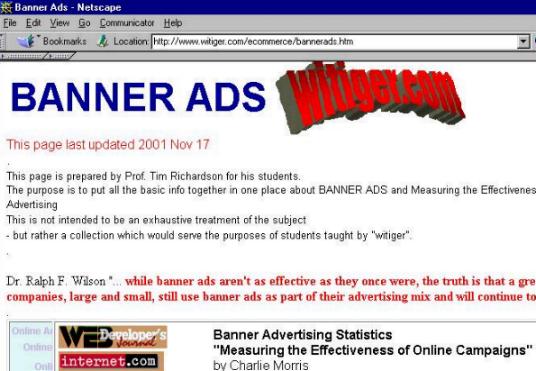
"Web Ads To Make Content
Sites Profitable By 2005 - Forrester"
www.newsbytes.com/news/00/159427.html
Featherly notes that "... Dot-com news, music and entertainments sites have been laying people...a new report by market analysis firm Forrester Research predicts that if such companies can hang on for just two more years, profitability will arrive. And the oldest media revenue source - advertising - once again will step in as the savior."
Feathjerly quotes Forrester
media analyst Eric Scheirer
"it's very difficult for
sites that are advertising-based to be profitable today. But that's changing,
and very rapidly"
"Says Scheirer, as advertisers continue flocking to the Web to get the word out about their products, they will be forced to compete for many of the same "super-target" online content pages - search-query returns on Yahoo and the shopping-bot results on the MySimon.com site are two examples. But not all advertisers will be able to schedule ad appearances on those pages, nor will they wish to pay the high price those ad slots will fetch, according to the Forrester report. Instead, the study says, the trickling will begin. Just below the "super-target" site grade lies what Scheirer labels "premium" site pages, well-contextualized pages of content designed to work with targeted ads"
"There is no doubt, the analyst says, that the current picture is bleak, and that many online publishers could be convinced to throw in the towel now....But patience will bear fruit, the analyst insists."
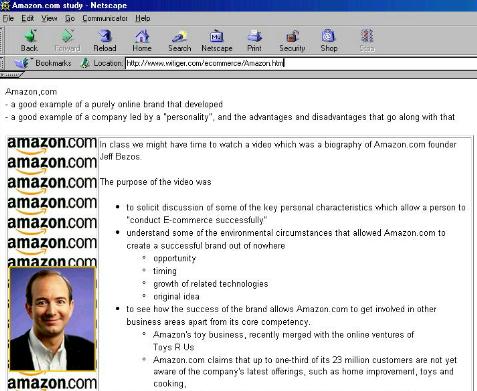
.
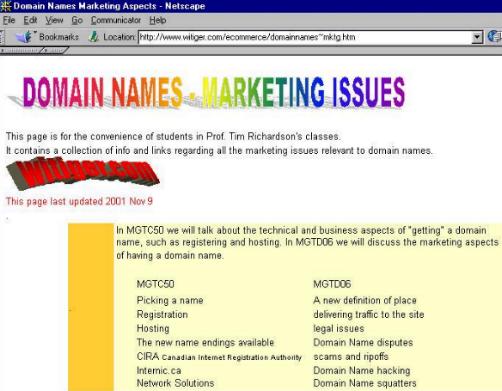 .
.
.
.
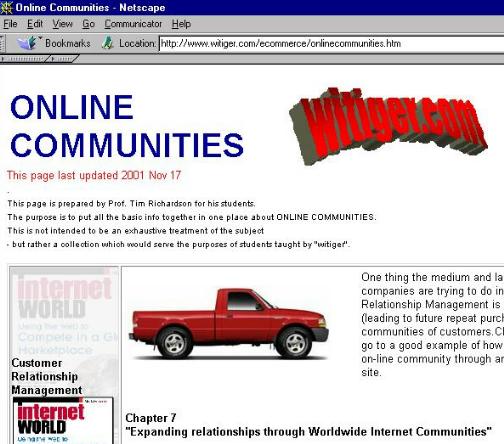
.
Chpt 8

Chpt 8
|
"Technology Enabled Relationship Management"
page 300 in the Schneider/Perry book, 2nd Edition "The nature of the web, with its two way communication features and traceable connection technology, allows firms to gather much more information about customer behaviour and preferences than they can using micromarketing approaches" "Technology Enabled Relationship Management occurs when a firm obtains detailed information about a customer's behaviour
|
| Technology Enabled Relationship Management
= CRM Customer Relationship Management (with some qualification)
Technology Enabled Relationship Management would, strictly speaking, apply to customers, vendors, partners, government agencies - anything you want to have a better relationship with, using technology such as the internet As Schneider and Perry explain on page 300, the term Technology Enabled Relationship Management is not so often used and it is more common to speak of Customer Relationship Management - that is to say using the internet to facilitate longer term relationships, and more profitable relationships with customers by using internet situations - and, like many things since 1998, you can use an "e" prefix and call it eCRM |
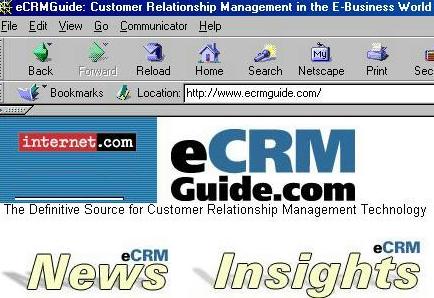 |
This is a good portal - which covers many eCRM topics |
.
.
.
|
|
CONTACT IMAIN PAGE I NEWS GALLERY I E-BIZ SHORTCUTS I INT'L BIZ SHORTCUTS I MKTG&BUSINESS SHORTCUTS I TEACHING SCHEDULE |
| . | |
| MISTAKES I TEXTS USED I IMAGES I RANK I FORMER STUDENTS I | |
| . |